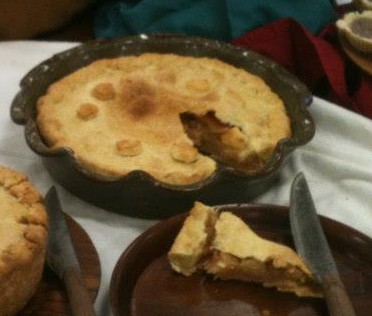Introduction:
Another item from first course of the Taming of the Shrew event. Mentioned repeatedly in Scappi’s menus, strawberries were in (just barely) in season locally, and when served and eaten with the Foccacia, reminded many diners of strawberry shortcake. No one ever complains about strawberry shortcake…
Dinner for the 8th of April:
First course from the credenza, item: Ricotta passed through a syringe, with sugar on top
Dinner for the 25th of April
First course from the credenza, item: Fresh ricotta topped with sugar and rose water
First course from the credenza, item: Hulled strawberries topped with sugar
Discussion
- The word ricotta literally means recooked. In modern English, ricotta cheese can refer to a creamy cheese made from whole milk, or it can refer to the original definition, which is a cheese made by heating leftover whey that has already been used for cheesemaking. This second heating is usually to a higher temperature than the first batch of cheese, and captures remaining milk protein, mostly casein, from the whey, using the natural acidity of the way to coagulate the cheese. This type is probably what was referred to by Scappi. According to , the “whole milk” version unsurprisingly has a significantly higher (11% vs 1%) fat content than the version made from “used” whey. It also has a slightly (80% vs 82.5%) lower moisture content. The whole milk version is modernly more common, and as I wasn’t planning on making another cheese, it was the logical choice for this feast.
- Scappi also refers to serving “cream tops”, which he describes the making of in recipe Book VI, recipe 145. The process he describes is one of heating up milk, then allowing to cool and for the cream to separate. When utilized on unhomogenized milk this process result in a layer of “milk skin” with a significant cream content. This is still a delicacy called nata in Spain and Portugal, and is made by heating full fat milk then cooling, as in making yogurt. . Therefore, I don’t think the idea of a whole-milk cheese of this type would be remarkable on Scappi’s table.
- This was a partially cultured cheese, partially acid-set, using a mesophilic (medium temperature) culture as well as citric acid. Mesophilic bacteria sours milk but in a less-tart way than thermophilic (heat loving) cultures, as are modernly used for yogurt. They do, however, work more slowly than thermophilic bacteria, which was why the cheese was part culture, part acid rather than fully cultured. I simply didn’t have storage to keep the 4+ gallons of milk and cream at the appropriate temperature for the full 24+ hours that type of culture requires, so I let it work as long as I had time for and then added additional citric acid to reach the appropriate pH. (Not that pH testing strips are appropriate for Scappi’s kitchen… but sometimes one can use technology to make up for inexperience.) Pure citric acid was used rather than lemon as I had it on hand from another project and I didn’t want to add a lemon flavor to the cheese.
- I added sugar and extra cream before serving – the ricotta had solidified overnight and I wanted it to be more creamy, and I also wanted the sugar to be throughout the cheese for even sweetness rather than concentrated on top.
- The labor-to-spiff factor of “piping” the ricotta wasn’t really sufficient to justify it, so it was simply served in bowls.
- I chose the “non-rosewater” version of the serving suggestion based both on avoiding redundant flavors (planning to serve an Elderflower-and-Ricotta tarte in another course ) and reducing allergens (I knew there was at least 1 diner at the feast who avoids flower extracts such as rosewater and elderflower liqueur; while I don’t mind serving one dish a particular person can’t eat, I generally avoid serving multiples.)
Piped Ricotta with Strawberries
Ingredients
4 gallons whole milk
32 oz cream (divided)
Yogurt Culture – per package directions, ratio of liquid to culture varies
Citric acid
- For Serving
Strawberries
Sugar
Directions
- Mix milk, half of cream, and yogurt culture, warm to ~110°F and hold for 2-3 hours. The pH should reach 6 around the 2.5 hour mark – needs to be between 5.9 – 6.1.
- Heat to 185, slowly (it should take 30 min). Stir and scrape the bottom during heating to avoid scorching.
- Increase heat and bring to ~200°F without additional stirring. Basically, this is as hot as it can go without any churn, the crust forming at the top shouldn’t break.
- Turn off heat, cover, and wait 15-20 min.
- Use slotted spoon / spider to skim curds into bowl lined with cheesecloth. Drain gently; the fluffiness will be harmed with rough handling.
- Finish by adding sugar to taste and mixing in additional cream until the ricotta reaches the serving consistency you’d like.

One Comment